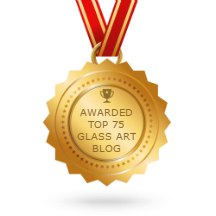Happy New Year, Everyone! I hope you all had a wonderful holiday season.
Are you ready for the New Year? I am and ready for an aggressive New Year’s Resolution – Continuous Experimentation!
Sometimes with my glass work I take the easy road and make pieces similar to other pieces I have made before. I don’t plan to stop this completely as if something sells, then perhaps another like it will sell. But I also do not want to lose my drive to experiment, so I am setting my goals high.
Over the last year, I have had quite a few surprises. Pieces like two vases that I thought would look exactly the same ended up draping differently. Was it the glass, the color, or something else? I have heard from others that different colors melt at different temperatures. So how does this affect a piece you are making? Also, often what I thought a color would end up looking like, didn’t. So this year, I am going to do many experiments changing only one variable at a time and see what I can learn from it all.
Where to start? Let’s try something for Valentine’s Day since from a Marketing perspective, it appears I am behind. 🙂
Before beginning you have to pick a base glass and powder which you know will have a reaction with each other. Sulfur reacts with Lead as does Sulfur and Copper. I can find the properties of each color on Bullseye Glass’ website at http://www.bullseyeglass.com/products/about-our-glass.html. Pick the color you want to explore and then select the Sheet Glass tab and it will tell you what chemicals that color contains.
I chose French Vanilla as the base color which has sulfur in it. And then a Salmon Pink powder which has lead in it. When combined the salmon pink takes on a brown reactive color.
The second thing you need to decide is what stencil you are going to use. I chose hearts, but you can use stencils in any shape or actually real objects like sea shells.
HINT: In order to make the objects easier to remove without affecting the powder, I always take a piece of masking tape and make a little handle and then stick the tape on the stencil. Then you just have to pick the stencil up straight using the handle.
Here are the steps to create your plate:
- Cut your base color (French Vanilla here) and cut it to the size of your place. I made one 9″ square. Cut a piece of clear to get to the right thickness, but make sure when you lay your piece out, that clear is on the bottom and French Vanilla on the top so it can react.
- Similar to what I explained in using powder in a previous blog, set up your environment so that your pieces are elevated so you can get your fingers under it to move it to the kiln. I always put wax paper down on the table so I can recover the extra powder and use for something else. So wax paper, then an upside down container and then my clean pieces of glass on top.
- Now apply your stencils where you want them.
- First apply a coat of Clear powder all over the plate. This will stop the reaction where you have applied the clear as the Salmon Pink powder will not react with the clear.

French Vanilla with Stencils and Clear Powder
- Then carefully remove the stencils.
- Now apply a coat of Salmon Pink powder over the entire plate. In some places it will cover the clear powder and in other places where the stencils were, it will go directly onto the French Vanilla sheet and have a reaction.

French Vanilla with Stencils Removed and then Covered wtih Salmon Pink Powder
- Carefully move your piece into your kiln and fire to a full temperature.
Voila! You can see the reaction in the plate where the stencils were for the hearts. And you can see in other areas the Salmon Pink. Of course, you can also see reactions in other places. This is because I did a light coat of the clear powder rather than a heavy coat as I like to see the reaction come through lightly around the stencils. If you wanted more pink, then apply your pink heavier especially over the clear powder.

Completed Hearts Plate of French Vanilla and Salmon Pink
What other colors react? I have seen Jade Green (copper) react nicely with Marigold Yellow (sulfur) and Turquoise Blue (copper) with Golden Green (sulfur). So I am going to search for another set of colors that I haven’t seen or tried and try them next!
Have you played with reactions? What colors do you like to combine?
Thanks to Bullseye Education and Bonnie Celeste for the Reactive Class which taught me so much!
Read Full Post »









